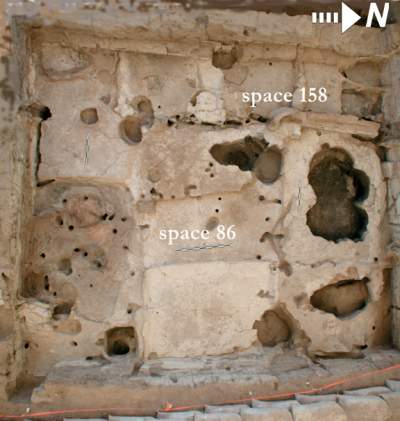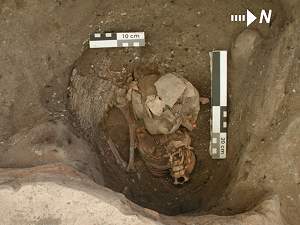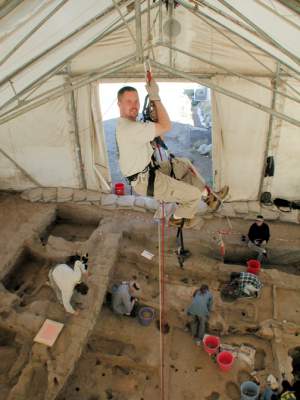BACH1 Area Excavations
Mirjana Stevanovic and Ruth TringhamThe BACH team excavated for 5 weeks in June and July. The primary aim of the season was to continue and possibly finish excavation of the Building 3 (space 86 and 158) in order to undertake a study season in 2002. We continued the partial excavation of Space 85 located immediately to the west of Building 3 in order to clarify the phasing of the west wall.
In the 2001 season we were once more reminded that the complexity of this building is even greater than originally perceived. In addition to the four post-occupational phases in the history of Building 3, we have defined 4 to 5 phases in the occupation of the building which coincide with changes in its configuration of rooms and platforms and floor construction. By the end of the 2001 season, we had excavated all the platform floors from phases 2 to 5, and much of phase 1. In the central floor area and space 158, the floors of phases 2 to 5 have been excavated (Figure 11).

Figure 11: Overhead view of Building 3 after the removal of interior walls
As excavation of the two small internal walls and the screen wall and its pillars proceeded in 2001, it became clear that in the early phases of Building 3, the two rooms - spaces 86 and 158 - comprised one large room, now designated space 201. Possibly from the earliest phase, some kind of screen-wall partitioned space 201, and in phase 2, a small northern wall. It was not until phase 4, however, that the composite partition formed by the two small internal walls, two pillars and the elaborate white plastered screen wall was added.
In 2001 in space 86 one more single burial of an infant, and a composite burial was excavated bringing the total number of burials under the floors to eight. The infant burial occurred in the Central floor area between and earlier than the two infant burials excavated in 2000. The infant was buried in a poorly preserved basket (Figure 12). A strand of clay beads had been placed on each of its upper arms, dark-coloured ones on the right side and light-coloured ones on the left side. A freshwater shell that was used as a vessel for cinnabar (a red mineral) and a material whose composition is unknown had been placed near the top of the head. The shell was covered on the outside with resin. Next to this - also under the top of the head - was a bone pin partially embedded in green pigment. Remains of uncarbonized wood, which could have been a part of a little wooden box in which all the mentioned items were placed, were also excavated nearby. |
 Figure 12: Infant burial and remains of basket |
The composite burial was excavated in the NE platform. The latest burial of this series was of a young child buried in a basket. Just before this burial, a mature woman of 40-45 years of age was buried. Her remains were fully intact and her burial cut into and partially disturbed two earlier burials, both of adolescents. These probably represent the first burial under this platform. No grave goods were found with these burials, but evidence of basketry and rope associated with the burials provide significant information on the burial ritual.
 Figure 13: Michael Ashley-Lopez suspended from the tent rafters in order to take vertical photos of the BACH1 excavation |
The burials so far excavated all belong to different phases in the history of Building 3. The three infant burials found in close proximity to each other in the Central floor area of space 86 are the earliest yet found in Building 3, belonging to phase 2. The four burials in the NE platform and the adult male in the NE platform belong to phases 3 and 4. In each phase we can recognise a main oven in use, along with smaller ovens. All of these are in the southern part of the building, including in the former space 158. The detailed excavation of floors in the western part of Building 3 (space 158) revealed a number of storage bins as well as ovens. One very interesting feature that was found next to the dominant oven of phase 3 was a white plaster bowl that was filled with over 700 small clay balls. The remaining few floors belonging to the earliest phase will be excavated in a short season in 2002. We are planing to carry out our study season parallel with the excavation. |